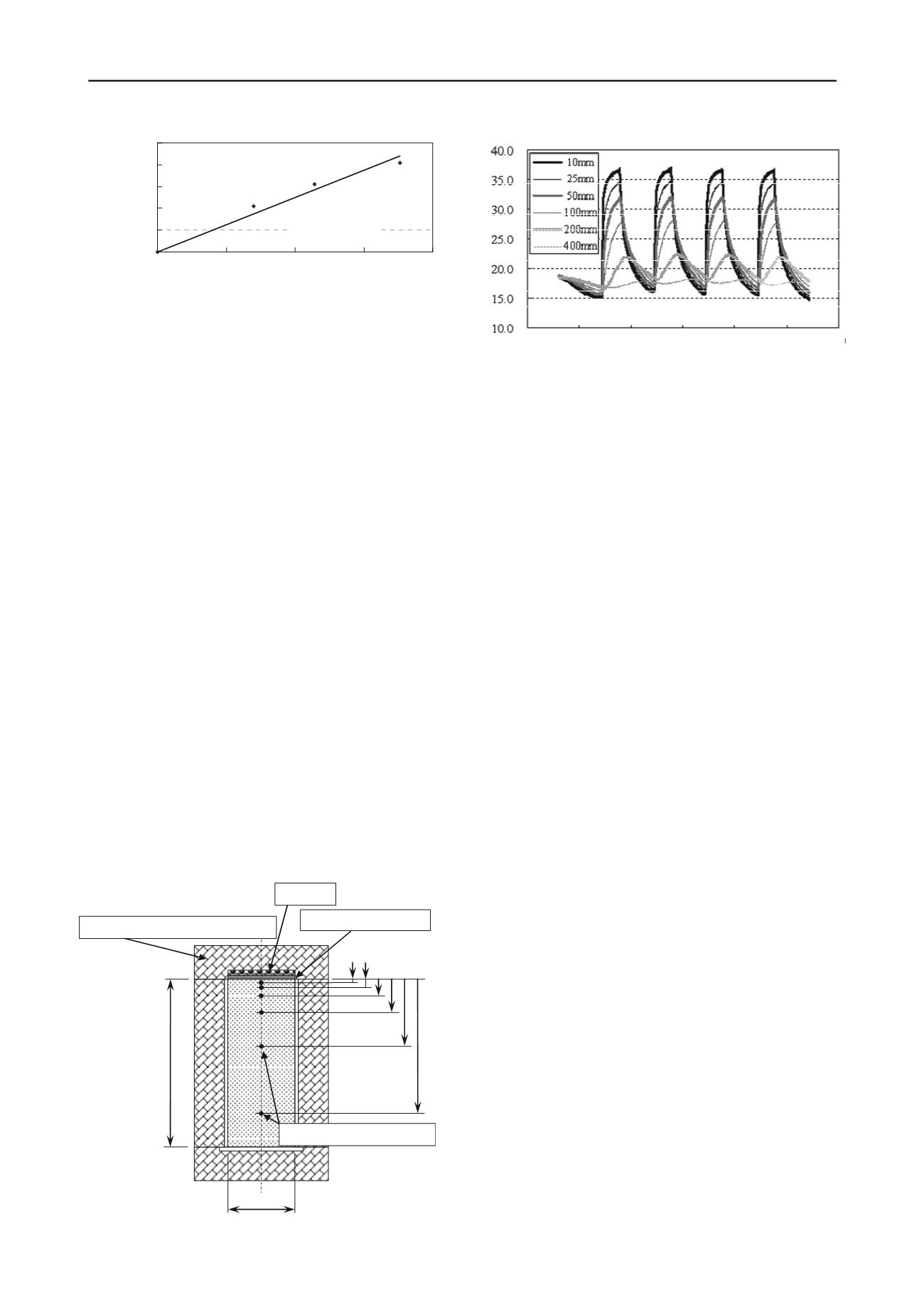
3118
Proceedings of the 18
th
International Conference on Soil Mechanics and Geotechnical Engineering, Paris 2013
thermal insulation (t=100mm)
200m
500m
heater
aluminum board
1025
50
100
200m
400m
temperature sensors
1
st
day 2
nd
day 3
rd
day 4
th
day 5
th
day
Lapsed days
temperature
er
maximum to be overdue in proportion to the distance from the
heat source. It is shown that the heat conduction inside the
specimen is accompanied by a time lag and attenuation. The
nd has been proposed to maintain the
ent in the stone chamber.
5 ASSESSMENT FOR HEAT CONDUCTIVITY OF SOILS
Subterranean preservation of food using the adiabatic effect of
the ground is widely performed from ancient times. The shelter
building for the Garandoya Tumulus has hence been covered
with soils to ease the temperature change in the tumulus
because the variation in temperature has a harmful influence on
the conservation of the mural paintings in the stone chamber.
The chamber model test is carried out in order to derive the
characteristics of the heat conductivity of the soil that is used
for the restoration of the tumulus. The schematic view of the
experimental device is shown in Figure 9. The soil is prepared
by ompacting to 50mm per layer and the specimen of ten-lay
L= tan
×497.6
0
20
40
60
80
100
0.00
0.05
0.10
0.15
0.20
tan
limit length Lcm
Fiigure.10 Experimental results on variation of temperature in the soil
Figure 8 Relation of the inclination angle of the foundation
and the
limit length L for capillary barrier
c
structure is developed. Then, the specimen is prepared with 200
m in diameter and 500 mm in height in the cylindrical
container of acrylics covered by the thermal insulated styrene
foam with a thickness of 100 mm. As is shown in the figure, the
mperature sensors have been arranged at the prescribed depth
in the specimen. The heat source of aluminum board is set at the
top of the container.
The sequence of heat supply is set to provide 40°C of heat for 8
hours from the top of the specimen followed by removal of heat
for 16 hours (1-day cycle model). During the time without heat
pply, the temperature of the specimen surface is falling to the
m
te
su
one of the room (about 15°C). Figure 10 shows the
experimental results of the heat conductivity on the soil used for
the restoration of the tumulus. The setup condition is equivalent
to the prescribed one for the restoration of the tumulus. As
shown in Figure 10, 4 cycles of heat supply and removal are
conducted. The increasing rate of temperature tends to be higher
in inverse proportion to the distance from the heat source. The
absolute value of temperature is so high that it is close to the
heat source, and there is the tendency for time to reach the
one-dimensional equation of heat conduction is solved by the
finite difference method. By fitting these data, the coefficient of
heat conduction
=8.04x10
-5
(J/ms°C) is obtained. On the basis
of the heat conductivity chamber test results, the candidate soil
for the restored mound is found to have a sufficient capacity as
an adiabatic material.
Geotechnical assessment was conducted to conserve the
Garandoya Tumulus with the naked stone chamber in which the
colored mural paintings are drawn. The preferable environment
in the stone chamber is found to be achieved by equipping the
shelter building covered by the earth mound. The seasonal
change of the underground level that is interlocked with the
river level has been monitored. The rise of the water content in
the capillary zone above the groundwater level was not detected
irrespective of the season. Underground water hence does not
infiltrate into the stone chamber from the ground. The layered
structure of the restored mound, namely the drained gravel layer
overlain by the compacted earth is expected to provide the
capillary barrier at the border of the layers. The chamber model
test results showed the linear relationship between the limit
il
6 CONCLUSIONS
layers. Capillary barrier effect is found to possibly assist for the
water resistant structure of the tumulus mound. The adiabatic
effect by the restored earth mound is experimentally confirmed
through the one-dimensional heat conductivity chamber test. On
the basis of the experimental results, the necessary thickness of
he restored earth mou
length, L and the tangent of the inclination angle of the so
t
desirable thermal environm
7 REFERENCES
Hita Municipal Board of Education, 2010: The investigation
report of accompanying preservation maintenance of the
historical site of Garandoya ancient tomb
Hita-City, 2008: A historical site of Garandoya ancient tomb
drilling survey commissioned business report.
T. Morii, A. Horie, M. Kikuchi, Y. Takeshita, and M. Inoue,
2005: Prediction of the capirally barrier effect of gravel
ground, Proceedings of the 40th geotechnical engineering
research exhibition, pp.1325-1326.
Figuare.9 Outline of the experimental device about heat conduction


